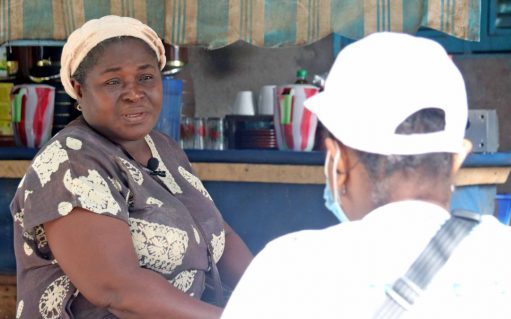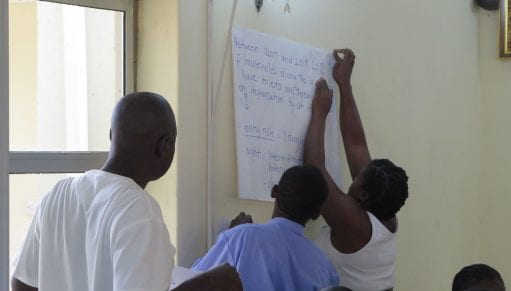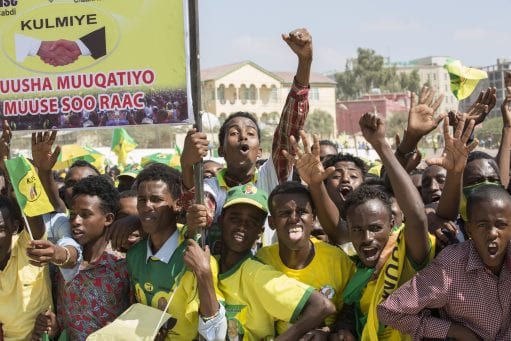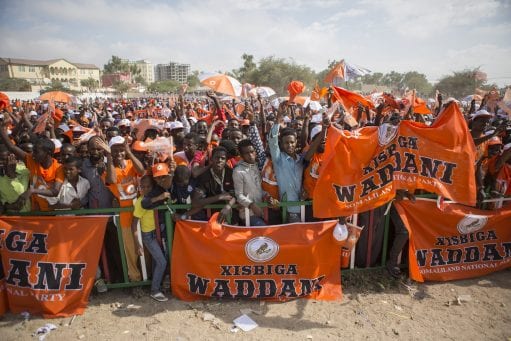Social Networks and Street Changes: A Lagosian Housing Story
By Yimika Koya, on 29 June 2022
Introduction
This housing story follows the journey of Mum and Dad, who also happen to be my parents. Characteristically, Mum is Fire while Dad is Ice, but their housing visions and strategies ultimately align in response to two major themes. Through conversations with both characters supported by secondary sources, this essay illuminates the notion of social networks for housing and their socio-economic advantage (or lack thereof) to individuals. Secondly, this essay explores residential land-use conversion, where for specific reasons, residents are displaced because of informal and gradual residential to commercial land-use changes.
Starting in the backhouse
Mum and Dad began their housing story at 30 Aramide Street, Ikeja, Lagos. Dad had lived in the compound since 1990 after he migrated from the nearby city of Ibadan. Mum had also relocated to Lagos in 1986 but only joined Dad in 30 Aramide after their wedding in 1994. The couple were part of the massive immigration into Lagos, contributing to the rapid population growth from 350,000 in 1950 to 25,615,703 today (MEPB, 2019).
30 Aramide belonged to Dad’s father, Papa. Papa bought the three-bedroom detached house on a 1247 sqm plot of land in 1963 from the Western Nigerian Housing Corporation (WNHC), a public organisation mandated with the “development, construction and management of housing estates” (Onibokun, 1971) for the Western Region of Nigeria. The establishment of the First Republic of Nigeria in 1963 sub-divided the federal government into four semi-autonomous regions, rendering WNHC a federal entity. On the promise of a new country, WNHC ambitiously established the Ikeja Industrial Estate “consist[ing] of 500 acres developed for industrial establishments and 300 acres for housing” (Abiodun, 1976, p.343). Aramide Street was intended to accommodate higher-income managerial staff facilitating the Estate establishment. While WNHC hoped to accommodate lower-income workers in apartment blocks (ibid.) and offer more accessible payment plans, they did not urgently address this agenda. Instead, by the Corporation’s dissolution in 1966 (after the Republic’s first coup), only 505 homes[1] were built and all were sold for GBP1000 to GBP4000 to “top government and quasi-government officials, professionals, big businessmen, and high-ranking politicians” (Stren, 1972, p.504 cited Ogunpola 1969, p. 3). With friends in high places and USD4200 to spare, Papa secured freehold ownership of 30 Aramide.

Figure 1.No photos of homes on Aramide Street were found however this image illustrates a similar high income house model in Bodija estate by WNHC.Photo from Nigeria Nostalgia Project
Papa initially leased 30 Aramide to Chinese expatriate families. In 1973, however, Papa’s seventh child moved into the main house, while the ninth child moved into a newly built structure behind the main house called the backhouse… all at no cost. The backhouse was a small sand-crete one-bedroom bungalow with an open-air kitchen. In 1990, the seventh child moved into his own home, the ninth child relocated to the main house, and Dad (the eleventh child) moved into the backhouse. By 1973, seeking rental income on 30 Aramide was challenging. Nigeria was recovering from civil war, and the Western Region had been further divided into Lagos State and Western State. With such political instability, the country was not in a position to focus on industrial development. Besides, Papa was more than happy not to receive any financial income from 30 Aramide. As far as he was concerned, providing a soft landing for his young adult children in Lagos’s harsh environment was profit enough.
Naturally, the children were delighted to accept Papa’s benevolence because living in 30 Aramide was an opportunity they could not pass. Accommodation costs in Lagos have always been high. In fact, high rents in Lagos contributed to the national general strikes in 1964, and despite increases in minimum wages, rent continued to rise disproportionately (Stern,1972, p.503). In particular, Mum and Dad moved to Lagos at the peak of crisis caused by an economic emergency imposed by the Babangida military regime in 1985, followed by International Monetary Fund Structural Adjustments programmes in 1986. The naira had devalued from NGN0.77/USD in 1984 to NGN7.39/USD in 1990 (Iyatse, 2021). A state-imposed forex embargo encouraged a booming parallel market that demanded NGN10.70/USD (ibid.). In such conditions, how did people without generous families cope? This excerpt by Koenigsberger (1970, p.394) gives a clue: “Available accommodation became overcrowded, clandestine settlements sprang up on the outskirts of the big cities and squatters occupied open grounds near the city centres”.
Without Papa’s generosity, Mum and Dad could not afford to live in such a well-connected location. Fair enough, it was not on the Island.[2] Still, it was close enough to essential transport routes and the Lagos State Government Secretariat. Additionally, if Mum contributed rent towards her matrimonial home, she would not have been able to maintain her two-bedroom rented apartment for twelve years, where all her younger siblings lived at some point… free of charge. Papa and Mum recognised the value of oh-so-common rent-free family houses: Assets that mitigate against the social costs of poverty, particularly in contexts that lack well-developed social security systems such as Lagos (paraphrased from Korboe, 1992).
Fixing the backhouse
For a bachelor like Dad, the backhouse had been perfectly adequate. The ninth child had made modifications to include a living room and a dining room; The space satisfied necessary storage, rest, and wash functions. However, Mum had been accustomed to a different standard of living and things would have to change. Some of the modifications were necessary. For instance, the cooking-gas tank residing inside the small kitchen was rightly relocated outdoors. Mum and Dad had just begun building their businesses, and almost all discretionary income was reinvested in their respective ventures. Therefore, modifications were undertaken incrementally and within a tight budget, probably formulated by the ever-frugal Dad. In this case, incremental should not be mistaken for continual. Improvements were few and far between because the couple was willing to wait until they had saved enough money to afford the quality of construction they desired. Till today, Mum would say, “I don’t manage,” and the backhouse was structurally sufficient that they never had to.
Having avoided the cost of residential rent, the couple later indulged in less necessary improvements. Mum fondly recalls the most luxurious modification that literally transformed the couple’s life. In 1998, they converted a large closet into an en-suite bathroom fitted with white tiles and green sanitary wares to ease the burdens of caring for their first-born child (me). Green for no other reason than the joy it sparked in Mum. While they were at it, they repainted all the furniture in the main bedroom a glossy bright green to match the new bathroom. The backhouse served many vital functions for the young family. After all, Mum’s social stationery printing press started in its dining room. However, it was only a matter of time before they maxed out on modification value potential and outgrew their first home.
Moving to the main house
Eventually, Mum and Dad moved from the backhouse to the main house under exceptional circumstances. One would have expected the ninth child to leave the main house soon, Dad would move in, and the twelfth child would replace him in the backhouse. But when Papa died in 1999, he willed 30 Aramide to Dad. Papa had freehold ownership of 30 Aramide before the 1978 Land Use Act of Nigeria, “vest[ed] all Land compromised in the territory of each State (except land vested in the Federal government or its agencies) solely in the Governor of the State” (Federation of Nigeria, 1990). After the Land Use Act was ratified, his freehold ownership was replaced with 100-year leasehold ownership signed by the Lagos State Governor. Dad inherited the leasehold with 79 years left on the dial. Why Papa would will this valuable asset to his eleventh child in the backhouse instead of the ninth child in the main house, no one would say. Either way, Mum and Dad relocated to the main house, while the ninth child returned to the backhouse, thus breaking the established tenure arrangement in the family house. Indeed, the couple greatly appreciated the unfortunately circumstanced opportunity. Not only had they outgrown the backhouse, but the main house came with authoritative perks over the entire compound. For instance, they now controlled the operations of the electricity generator, essentially dictating the power supply on behalf of all residents in 30 Aramide – a fantastic privilege considering the incessant power outages that still plague Nigeria.
In 1999, the country had just ended a brutal military dictatorship and turned a new leaf as the Fourth Republic. The economy was on the up; Mum and Dad could have afforded to leave 30 Aramide and relocate to the Island where they would be closer to friends, and Dad could avoid the painful commute to his law firm. Instead, they decided to remain in Ikeja for the following reasons. Firstly, Mum had relocated her printing press to the boys’ quarters of 21 Aramide and wanted to stay within walking distance. Secondly, the couple had already been working the angles to secure a position for their first child in one of the city’s best schools nearby. Lastly, the Island notoriously flooded during the rainy season as the drainage infrastructure for the water-logged landscape was woefully inadequate. Paying rent on a home that flooded annually did not seem like good value for money. Remaining on the Mainland – on solid ground – did.
Changes on Aramide street
Unfortunately, the couple’s tenure in 30 Aramide would not last long owing to land-use changes on Aramide Street. In the 1970s, there had been about 60 households. Then came a Chinese restaurant, replacing a residential unit, followed by a furniture store and a logistics centre. The arrival of a mini-mall cemented the fate of the street as commercial. By 2001, only six households remained on Aramide Street. Some new businesses did little to amend the architecture of the homes, while others erected purpose-built offices. Observing the commercial land-use demands in Ikeja, the Lagos State government reactively demarcated some WNHC-zoned residential areas as commercial in the Ikeja Land Use Map of 1982[3] (Oduwaye and Enisan, 2011). Aramide Street is sure to have been rezoned. According to Mum, the transformation on Aramide Street was inevitable. The road was a major thoroughfare linking Alausa, Allen Avenue and Oba Akran Avenue, all major institutional/industrial areas. On the day of the Ikeja Cantonment Bomb Blast,[4] she recalls watching tens of thousands of people flood her street on foot, walking past her gate and observing her in her home. It was then that, with disdain, she realised she lived on the main road.
The tension between the desire for privacy and the reality of exposure was a historical theme for residents of Aramide Street. In 1980, all households replaced their steel mesh and hedge fences with tall brick walls. Every family also had a mai guard[5] who lived in a small gatehouse and provided base-level security[6] for free accommodation and a stipend. Dad went the extra mile and acquired eleven guard dogs. Yet, no measure was enough to fend off crime in light of the depletion of residential homes. The thought process of a criminal was that if no one was watching, one could easily get away with it. So it was, that when 30 Aramide stood between two commercial entities from 1999, several mid-night attempts were made to break into the compound. Mum suffered from anxiety and insomnia, but despite her worries, she did not comment on wanting to leave 30 Aramide.
Dad was grateful to live in 30 Aramide cost-free. But he certainly held no sentimental attachment to the home. It simply is not his nature. He had received many financially enticing offers for 30 Aramide, and he recalls feeling the pressure to be rational. Although, as someone who always plays the long game, he probably could have remained in 30 Aramide, knowing one of the eleven dogs could protect him. Yet, it took only one successful armed robbery attack in November 2001 for the pressure to be rational (financially) and responsible (for his family) to give way. A week later, he accepted a ten-year leasehold offer from a bank that would pay a substantial lump sum and another payment for demolishing 30 Aramide. He broke the news on an unassuming evening, informing Mum that she had just two weeks to find a new home before the Bank took possession.

Figure 2. The purpose built bank on the right sits where 30 Aramide family house once stood. The Chinese restaurant on the left has made little alterations to the original architecture built by WNHC
Lessons learned
Mum and Dad have since rented a three-bedroom home and now own a four-bedroom house. Both homes are in the gated community of Lira Housing Association (LIRA) Ikeja, a seven-minute walk from 30 Aramide. While their housing story has evolved, the threat of residential land-use conversion persists. Ikeja, in particular, has experienced a reduction in residential land from the initially planned 41 percent to 28.4 percent in 2010. Meanwhile, commercial land has increased from 9.5 percent to 46.06 percent. (Oduwaye and Enisan, 2011). Oosterbaan et al. (2012) highlight the widespread nature of residential to commercial conversations in sub-Saharan African cities. The process is typically informal, and many businesses promoting this phenomenon are small-scale. In response to the violation of land-use legislation, the Lagos State Physical Planning Authority (LASPPPA) is clamping down by sealing uncomplying buildings and imposing charges (Edeme, 2021; Olasunkanmi, 2021). However, Oosterbaan et al. (2012, p.63) rightly note that such sanctions could either stifle economic vitality or prove ineffective “considering the widespread, informal nature of the process, and the inadequate capacity of planning agencies to enforce such a law” (ibid.).
At a community level, LIRA is one of the few housing associations off the main road to resist land-use conversion. Aramide Street and the adjacent Adeniyi Jones Avenue remain favoured commercial axes, and businesses that cannot afford units on the main roads seek cheaper leases within housing associations. By joining the association, every resident within LIRA has agreed never to use, sell or rent their property for commercial purposes. The Executive Council – where Dad served as vice-chairman – fiercely enforces this rule to the extent that a fellow resident has been sued for using their property as an Airbnb. The resident claims an Airbnb does not qualify as a commercial enterprise, but the Council begs to differ. The case is presently pending in court.

Figure 3. Signposts outside the gates of LIRA
Is preserving the land use of LIRA worth the cost? To Mum and Dad, the answer is a vehement yes. Reflecting on the experience of being displaced from 30 Aramide, Dad says the following: “I have a right to safety and privacy. I should be able to stand on my balcony, let my guard down and wave at my neighbours. I should not have to deal with a restaurant or office and their associated trouble, traffic and strangers disturbing my peace. If the government cannot defend those rights, should we not do it ourselves?” The contradiction lies in the fact that Mum would not have been able to use the boys’ quarters of 21 Aramide and later the main house of 26 Aramide for her now thriving printing press presently on 24 Aramide if it were not for the informal conversion processes she opposes today. She would have been dragged to court, which would have been the end of her business. The real question should be, what determines a city’s spatial organisation? The neatly laid colour blocks on a map, the instincts of citizens, or both?
Note
The names of Aramide Street and Lira Housing Association (LIRA) have been altered to anonymise the identities of the main characters.
References
Abiodun, J. O. (1976). Housing problems in Nigerian cities. The Town Planning Review, 47(4), pp.339-347.
Dad(2022, April). Interview about 30 Aramide Street.
Edeme, V. (2021, November 19). Lagos govt decries conversion of residential buildings for commercial uses. Punch Nigeria. [online] Accessed April 22, 2022. Available at: https://punchng.com/lagos-govt-decries-conversion-of-residential-buildings-for-commercial-uses/
Federation of Nigeria (1990) Land Use Act, Laws of the Federation of Nigeria (ed)
Iyatse, G. (2021, October 18). Osinbajo’s prescription and painful history of naira devaluation. The Guardian Nigeria. [online] Accessed April 9, 2022. Available at: https://guardian.ng/business-services/osinbajos-prescription-and-painful-history-of-naira-devaluation/
Koenigsberger, O. (1970) Housing in the National Development Plan: An Example from Nigeria. Ekistics, 180.
Korboe, D. (1992). Family-houses in Ghanaian cities: To be or not to be?. Urban Studies, 29(7), pp.1159-1171.
Ministry of Economic Budget and Planning’ MEPB’ (2019) Lagos Socio-Economic Profile. [online] Available at: http://mepb.lagosstate.gov.ng/wp-content/uploads/sites/29/2019/11/11.0-LAGOS-SOCIO-ECONOMIC-PROFILE.pdf
Mum (2022, April). Interview about 30 Aramide Street.
Oduwaye, L. & Enisan, G. (2011). Effects of Global Economy on Spatial Structure of Ikeja. Proceedings REAL CORP, pp.1257-1265.
Ogunpola, G. A. (1969). The functioning of a statutory corporation: the case of Western Nigeria Housing Corporation 1958-1966. Quarterly Journal of Administration, 4(1), pp.31-44.
Olasunkanmi, O. (2021, March 3). Lagos set to enforce converted property in government schemes. Lagos State Official Government Website. [online] Accessed April 9, 2022. Available at: https://lagosstate.gov.ng/blog/2021/03/03/lasg-set-to-enforce-converted-property-in-government-schemes/
Onibokun, G. A. (1971). Housing finance in Nigeria: A critical survey of private and public sources. The Town Planning Review, 42(3), pp.277-292.
Oosterbaan, C., Arku, G., & Asiedu, A. B. (2012). Conversion of residential units to commercial spaces in Accra, Ghana: A policy dilemma. International Planning Studies, 17(1), 45-66.
Stren, R. (1972). Urban Policy in Africa: A Political Analysis. African Studies Review, 15(3), pp.489-516.
The Birmingham Post (1963, October 1) Swamp becomes industrial estate. The Birmingham Post, p.14
[1] 505 homes in all housing estates, including the Bodija Estate, Ibadan and the Ikeja Industrial Estate, Lagos.
[2] Lagos is divided into the Mainland and the Island. The Island is home to Lagos Island and Victoria Island, which serve as the city’s Business Districts.
[3] The Ikeja Land Use Map (1982) is not publicly accessible
[4] A armoury explosion at the Ikeja Military Cantonment that killed 1,100 people and displaced over 20,000.
[5] A security personnel. Typically, a rural-urban immigrant. The concept of a mai guard deserves its own housing story.
[6] They did not have any security training but acted as eyes on the street.
This housing story is part of a mini-series revealing the complex ways in which personal and political aspects of shelter provision interweave over time, and impact on multiple aspects of people’s lives. Space for strategic choice is nearly always available to some degree, but the parameters of that choice can be dramatically restricted or enhanced by context. The wide range of experience presented in this collection shines a light on the wealth of knowledge and insights about housing that our students regularly bring to the DPU’s learning processes.
 Close
Close






























